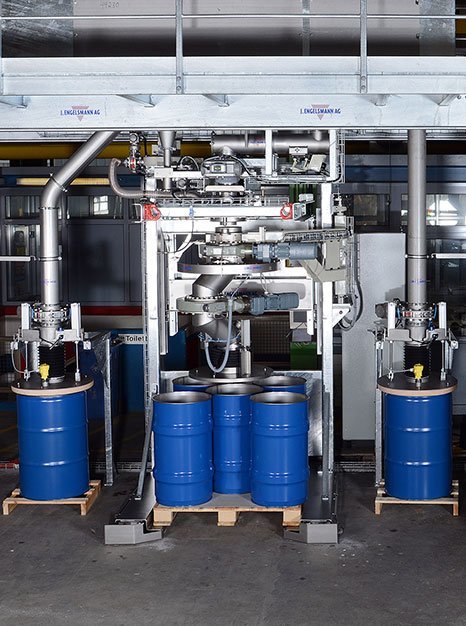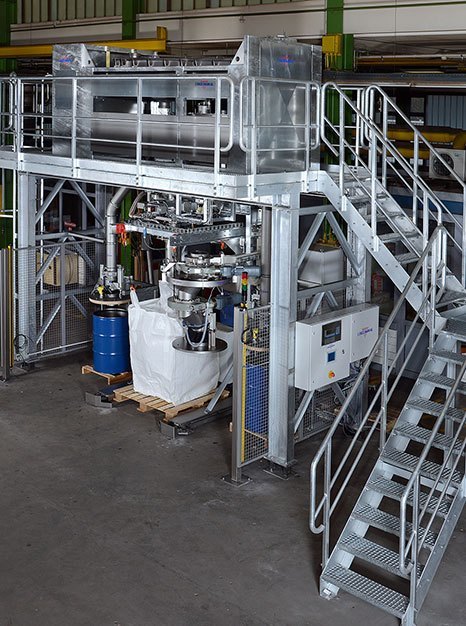Classify, fill, done: multiple filling in a confined space
Filling plants are used in various industries and areas of application. Integrated into current manufacturing processes, these plants are normally only permitted a small amount of floor space, and must operate to the highest degree of efficiency. What is more, the plants must also satisfy extremely high security requirements for both products and staff. A current project by bulk solids specialist J. Engelmann AG from the chemical industry demonstrates how it is possible to implement classification screening with the downstream filling of multiple containers at the same time with low area and personnel requirements.
The client, a producer of granular product from the chemical industry, needed a plant solution that could not only classify the spherical or extruded product, but could also perform product filling into up to five drums on a pallet or, optionally, into big bags in the smallest of spaces.
As the client's end user is supplied with either big bags or drums according to demand, a filling plant had to be designed that could do both: filling into drums and into big bags. A further challenge was the number of containers to be filled: the filling plant needed to provide a universal docking station for the simultaneous filling of four or five drums on a pallet, as well as for the individual filling of big bags. In addition to this, it should be possible to use the drums at various heights and to change the containers during the current screening process. Furthermore, the plant had to be low-dust, so as not to affect the health of the operator. The cramped conditions of the site required the plant to take up as little floor space as possible. In summary, the task was complex, with a wide range of requirements.
The simultaneous filling of five drums is possible
The Engelmann designers decided to use a freely swinging long-stroke screening machine for the screening process. It is used for the coarse and fine screening of granular product, whereby only the average grain range from 1.5 - 4.0mm is used as product for sale.
The sieved fine and oversized particles are passed through the downpipes which are placed under the screening machine into separate drums and then no longer used. A fill level indicator signals in good time when a drum is completely filled. A double actuator allows four or five drums standing on a pallet to be filled simultaneously. In order to achieve this, the offset design filling head is equipped with two electric rotary actuators that are powered and controlled independently from one another.
The correctly sized granulate flow into a 500 litre receiver tank or buffer container which is mounted below the screening machine, where they are collected until a container to be filled is connected to the filling scale. The receiver tank is equipped with a maximum indicator to prevent overfilling. In the case of big bag filling, the inlet nozzle is pulled over the filling pipe and the inflatable sleeve is activated. A shaping device ensures that the empty big bag is completely filled by expanding the liner of the big bag with a blower before filling.
Filling is initially performed using coarse flow. Shortly before reaching the target weight, the filling chute is switched to fine flow. Upon reaching the target weight, the filling chute is stopped and the metering flap closed to prevent granules trickling out. The ready-for-sale containers are weighed using an approved filling scale.
Low-dust drum filling or big bag filling as required
In order to achieve the highest possible plant availability, it is possible to change the container from a drum to a big bag (or vice versa) during plant operation, thanks to the buffer container. This conversion is possible with minimal effort and without the need to use a large number of tools. The complete drum fill unit, which is mounted on a separate swivelling arm, is simply swung to the side, allowing the filling pipe for big bags to be attached.
In order to achieve virtually dust-free filling, all relevant exhaust sockets are connected to a central dust extraction system, which allows dust and expelled air to escape through the suction. The cleaning and maintenance of the plant require very little effort. A high proportion of smooth surfaces facilitates the cleaning process. As the plant is modular and openly accessible, it can also be quickly dismantled.
The core of the plant is an easy-to-use control unit (SPS S7), which ensures that automated processes run smoothly. The menu navigation is clear and is supported by appropriate visualisation. An interface (Profibus DP) is provided for communication with the superior PLS (Freelance). Due to the high degree of automation, the entire plant can be operated by a single person.
Plenty of room for space saving
The 8.60 metre long, 3.60 metre wide and 5.60 metre high plant, including screening machine, has been optimally adapted to the given space and tailored to the on-site conditions and low space requirement. In the planning phase, care was taken to ensure the lowest possible use of floor space when designing the individual plant areas. As a result, the use of transport systems for containers or pallets, for example, is not necessary. Lifting devices for the filled containers were also done away with, as the empty drums can be positioned on the pallet during the filling process.
Thanks to the choice of drum or big bag filling, the multiple filling of up to 4 or 5 drums on a pallet, and the use of different container heights, the plant's operation can serve several of the client's different customers. The Engelsmann plant is a turnkey solution. When it comes to this project, the Ludwigshafen-based bulk solids specialist's range of services ranges from engineering, manufacturing and turnkey delivery to installation and final briefing. Cooperation with only one supplier or contact partner saves coordination effort and valuable time, meaning that the plant could be put into operation just four months after order receipt.
Components of the filling plant
- Freely swinging long-stroke screening machine
- Filling stations for fine and oversized particles
- Storage tank (500 L correctly sized granulate)
- Filling chute
- Metering flap
- Plant control
- Filling scale for drums and big bags
Brief overview of plant properties
- Container change (drum and big bag) during the current screening process
- Combination plant with the 4 and 5 times filling of drums, and optionally the single filling of big bags
- Low floor space requirements thanks to compact design
- Low downtime thanks to ease of cleaning and maintenance
- Less manpower required to operate the plant
- Classifying, filling and calibrateable weighing of ready-for-sale products using a plant
- Virtually dust-free operation
- Turnkey solution from a single source








